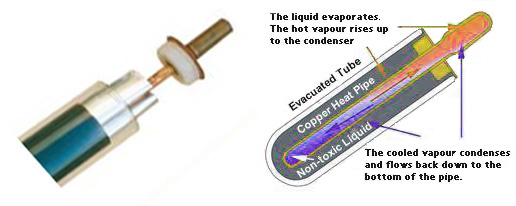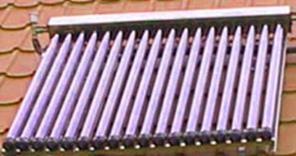
|
From East To West |
|
|
|
Solar Collect Limited © 2014 Registered in England and Wales, Company no. 6234018 Preston, PR2 8WB. |

|
The Principle of a Heat Pipe |

|
A Roof-Mounted Double Walled Vacuum Tube Collector |

|
Heat Pipe Technology
A double walled evacuated tube collector is similar in construction to a conventional domestic vacuum flask for storing hot liquids. It consists of two very strong concentric borosilicate glass tubes with the annular space between them evacuated so as to almost completely eliminate heat loss by conduction and convection.
The outer surface of the inner tube is coated with an advanced solar selective surface. This special coating absorbs almost all of the incident solar energy while emitting very little long wave infrared radiation. It thus behaves as a “super greenhouse”.
The heat energy is conducted via metal fins (usually aluminium) to the axial heat pipe. The heat pipe is a tube made from very pure copper that contains a small amount of deionised water under vacuum. At temperatures above 30 °C the water in the heat pipe vaporises.
The heat energy, in the form of latent heat of vaporisation, is then carried upwards by convection. The bulb at the top of the heat pipe is a condenser where the hot vapour gives up its latent heat and returns to the liquid state. It fits into a heat exchanger (the Manifold) through which flows the water to be heated. |
|
The proper use of a heat pipe confers certain advantages on the design: · It transfers heat extremely effectively. · Since convection can take place only upwards it reduces energy losses at night. · Since there is no water flow through the glass tubes it increases freeze resistance. · The vacuum tubes are non-leaking and replaceable without the need to interrupt the plumbing.
There exist also single walled vacuum tube collectors with a heat pipe and flat internal absorber.
Double walled tubes have the added advantage of a cylindrical absorber that “passively tracks” the sun, thus they tend to perform better over the whole day. For the same reason their exact orientation is not so critical in order to obtain optimum performance. |
|
Collector Size and Expected Savings
Required Aperture Area The average Western European household is usually reckoned to consume about 50 litres of domestic hot water per person per day, at a temperature of 45–50 deg. C. An annual total of energy of about 730 kWh/person is required to heat this water.
In central England a south facing surface, inclined at about 40 degrees to the horizontal, receives an annual total (direct beam plus diffuse radiation) of about 1000 kWh/m2 of solar energy.
A typical double walled vacuum tube solar collector, installed on a roof facing between SE and SW and inclined at 35- 45 degrees to the horizontal has an overall efficiency* of about 60%. The total amount of energy gathered is thus about 600 kWh/m2/year.
Therefore a collector with an aperture area of 1.2 m2 would more or less satisfy the annual hot water energy demand of a single person, if the solar power available were the same in all seasons of the year. (600 x 1.2 = 720 kWh) |
|
In Northern Europe the daily demand for hot water is almost constant all of the year. However the intensity of the incident solar radiation varies by a factor of four between mid-summer and mid-winter, for a collector that is inclined at an angle of about 40 degrees.
It follows that a collector large enough to meet the demand in winter would be considerably over sized in summer and would give rise to problems of overheating.
In the UK the usual design aim is to satisfy the demand almost completely in the summer and to achieve a yearly average solar fraction of about 55%, the remainder being met by the existing boiler or electric immersion heater.
On this basis a house with 3 full time adult occupants, would ideally require a vacuum tube collector of area 3 x 1.2 x 0.55 = 2.0 m2. For 2 and 4 occupants the figures would be 1.3 m2 and 2.6 m2 respectively. |
|
Saving Money
At a retail price of about £350.00 (inclusive of VAT) this allows about £600 for ancillary equipment (e.g. electronic controller, pump, solar tank and pipe work) and still gives a payback time of 5 years for a simple self installed system.
Saving the Planet
The recent steep rise in the price of gas has caused the large generating companies to open up only coal fired plants in recent years, with more planned for the future.
There has been much talk about carbon capture and storage technology (C.C.S.) as a possible way out of the impasse, while permitting “business as usual”. No such technology currently exists for large scale flue gas CO2 capture, and there is no proven method of storing the vast amounts of CO2 that are currently produced. (The UK generating companies produce about 200 million tonnes per year.)
(Information on UK CO2 emissions can be found at: http://www.defra.gov.uk/statistics/environment/green-economy/scptb01-ems/ )
(You can find a personal CO2 Calculator at: http://actonco2.direct.gov.uk) |
|
A Note on Domestic Hot Water Stores:
We would recommend however that a dual coil solar tank, such as the Newark cylinder of 143 litres is used. This is ideally sized to be used with the TS-20 collector and can replace a standard vented cylinder. We would recommend that the solar circuit always be of the closed type, either a drain-back system or a pressurised system with antifreeze for maximum frost protection.
A drain-back system requires a lower concentration of antifreeze (< 30%) and therefore a standard VA pump is adequate. You can still use a differential temperature controller, and you will save on other components, such as an expansion vessel, pressure gauge etc.
(The latter is advisable for those periods of exceptional weather when the temperature of the water in the main cylinder can rise above 70 °C.) |
|
To top of page |
|
To top of page |
|
To top of page |